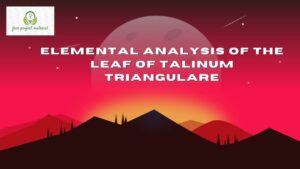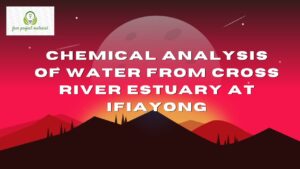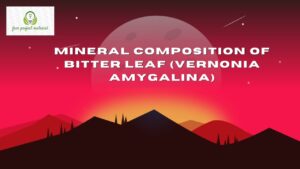ABSTRACT
The study was aimed at characterizing the chemical constituents of Costus igneus using FTIR. Standard analytical methods were used in the analysis of the samples. The result of this study revealed the presence of various functional groups. Which were primary amines, aliphatic amine alkanes aromatics carboxylic acids secondary amines, alcohols, and phenols. This shows that Costus igneus could be find applications in pharmaceutical industry for the production of drugs. Therefore more studies on the phytoconstituent with the use of instrumentation that gives precise output is recommended to affirm this study mean while, if the use of the plant in the treatment and management of diseases as discussed in this study is encourage.
TABLE OF CONTENTS
Title Page- – – – – – – – – – i
Certification- – – – – – – – – ii
Dedication- – – – – – – – – – iii
Acknowledgement- – – – – – – – iv
Abstract- – – – – – – – – – v
Table of Contents- – – – – – – – – vi-vii
CHAPTER ONE
INTRODUCTION
1.1 Background of the Study- – – – – – 1-3
1.2 Aim and Objectives of the Study- – – – – 3
1.3 Scope and Limitation of the Study- – – – – 3
1.4 Definition of Terms- – – – – – – 3-4
CHAPTER TWO: LITERATURE REVIEW
2.1 Description of Costus igneus– – – – – – 5-6
2.2 Species of the Plant – – – – – – – 6-8
2.3 Medicinal Uses of the Plant- – – – – – 9
2.3.1 Anti-Diabetic Effects- – – – – – – 9-10
2.3.2 Hypolipidemic activity- – – – – – – 10
2.3.3 Diuretic effect- – – – – – – – 10-11
2.3.4 Antioxidant activity- – – – – – – 11-12
2.3.5 Anti‑microbial activity- – – – – – – 12-13
2.3.6 Anti‑cancer effect- – – – – – – – 13
2.3.7 Putative activity- – – – – – – – 14
2.4 Methods of Characterization – – – – – 14
2.4.1 GC-MS- – – – – – – – – 14-16
2.4.2 Purge and trap GC – MS- – – – – – – 16-17
2.5 Types of mass Spectrometer Detectors- – – – 17
2.5.1 GC – Tandem Ms- – – – – – – – 18
2.6Applicants Of GC – MS- – – – – – – 19-20
2.7 Fourier – Transform Infrared Spectroscopy- – – – 20-21
2.7.1 Component of FTIR- – – – – – – 21-23
2.8 Applications of FTIR- – – – – – – 23-24
CHAPTER THREE: MATERIAL AND METHOD
3.1 Materials and Reagent- – – – – – – 25
3.2 Sample Collection- – – – – – – 25
3.3 Sample Preparation- – – – – – – 25-26
3.3.1 Analysis of Sample Using FTIR- – – – – 26-27
CHAPTER FOUR: RESULTS AND DISCUSSION
4.1 Results- – – – – – – – – 28
4.2 Discussion- – – – – – – – – 29-32
CHAPTER FIVE: CONCLUSION AND RECOMMENDATION
5.1 Conclusion- – – – – – – – – 33
5.2 Recommendation- – – – – – – – 33-34
References
CHAPTER ONE
INTRODUCTION
1.1 Background of the Study
Medicinal plants are the valuable source of natural active compounds for maintaining human health and treatment of many human diseases. The bioactive compound are alkaloids, phenols, tannins, flavonoids, vitamins and minerals which are found to have antioxidant, antitumour, antibacterial, anticarcinogenic and diuretic properties. Therefore there is a need to study the ethnomedicinal use and importance of herbal medicinal plants in the discovery of novel drugs. Most of the synthetic drugs used to cure human aliments have their origin from plant products (Maluventhan, 2010).
Phytochemicals are naturally occurring in the medicinal plants leaves, vegetables and roofs that have define mechanism and protect from various diseases. Phytochemical scientists due to the development of newer technology and sophisticated outcome. These techniques play a significant role in findings of important material for pharmaceutical industry. Plants have substance that induce a great interest due to their versatile application (Baris and Gulluce, 2006). It is estimated that 14-18% of higher plants are used medicinally and related to 74% of pharmacologically active plant are discovered after following up on ethnomedicinal usage of the plants. (Ncube, 2008). The plant Costus igneus belongs to the family costaceae, which is found in tropical Africa, Asia, Australia and North, Central and South America. In India, it is cultivated in coastal area, Uttar Kannada district of Kamataka. In this arca, people take traditionally 2 – 3 leaves of this plant twice a day for the management of diabetes. It is a prostrate growing plant with spreading, rooting stems. Its leaves are slender and lance shaped with tooted scalloped or lobed margins. They are greyish green stained with red purple above and darker purple beneath. The tiny white flowers grow intermittently throughout the year. This plant reaches of height of 6 – inches and have an indefinite spread. Considering the medicinal importance of these widely available plant species the aim of the present study was to identify the Qualitative and Quantitative Phytochemical Analysis of Costus igneus.
Fourier – transform infrared spectroscopy (FTIR) (Hassel, 2007) is a techniques used to obtain an infrared spectrum of absorption or emission of a solid, liquid or gas. An FTIR spectrometer simultaneously collects high resolution spectral data over a wide spectral range. This confers a significant advantage over a dispersive spectrometer which measures intensity over a narrow range of wave length at a time. The term Fourier transform (a mathematical process) is required to convent the raw data into the actual spectrum.
1.2 Aim and Objective of the Study
The aim of the study is to characterized ethanolic extract of Costus igneus using FTIR.
1.3 Scope and Limitation of the Study
This study only focus on the chemical characterization of Costus igneus leaves using FTIR. This study is delimited due to time and financial constraints.
1.4 Definition of Terms
Costus igneus: Commonly known as insulin plant in india, belongs to family costaceae. It is believed that consumption of the leaves helps lower the blood glucose levels and diabetics who consumed the leaves of this plant a fall in their blood glucose levels.
Gas chromatography – Mass spectrometry is a potent tool for identifying the bioactive present in the natural product.
FTIR: Is a technique used to obtain an infrared spectrum of absorption or emission of a solid, liquid, or gas. It simultaneously collects high-resolution spectral data over a wide spectral range.



